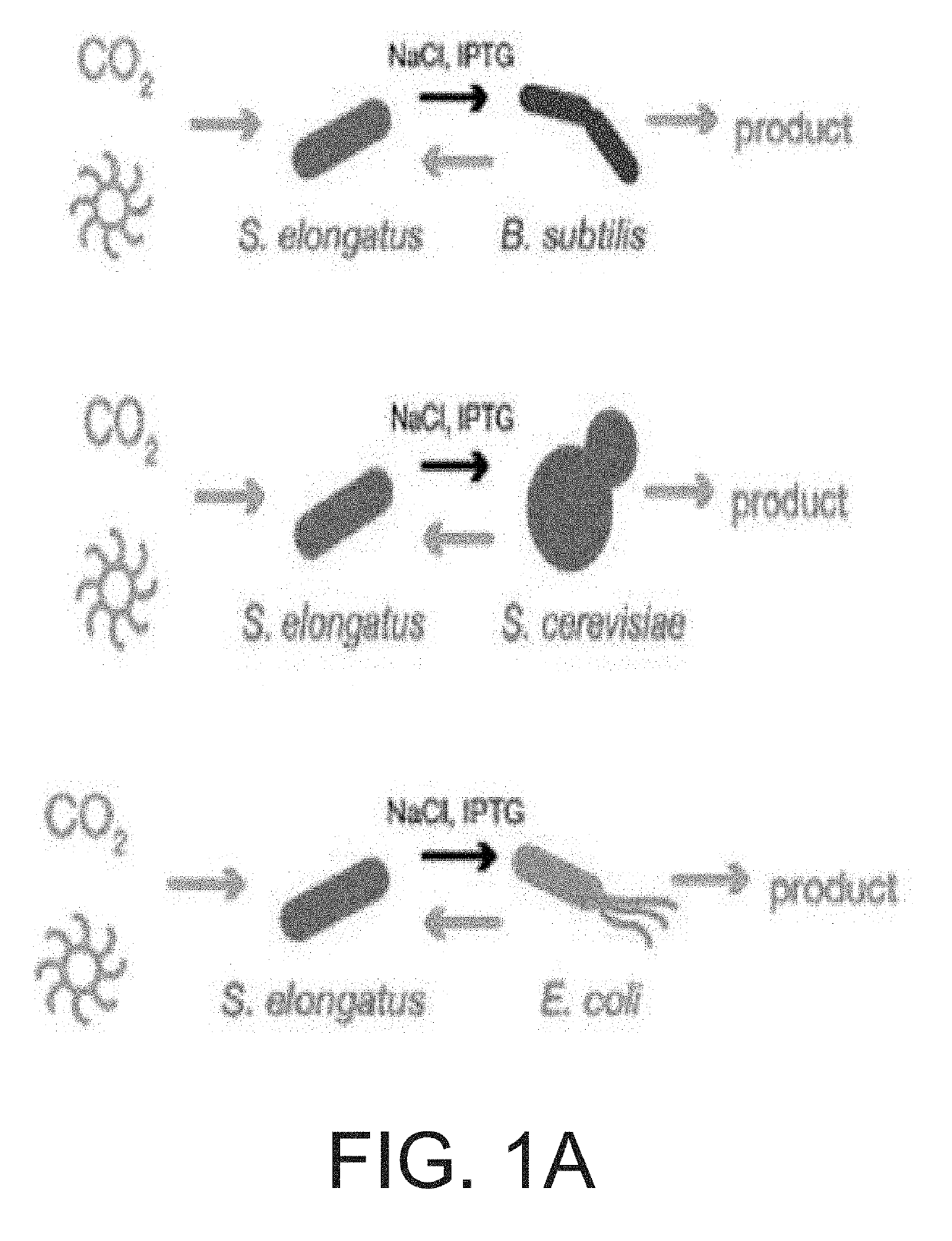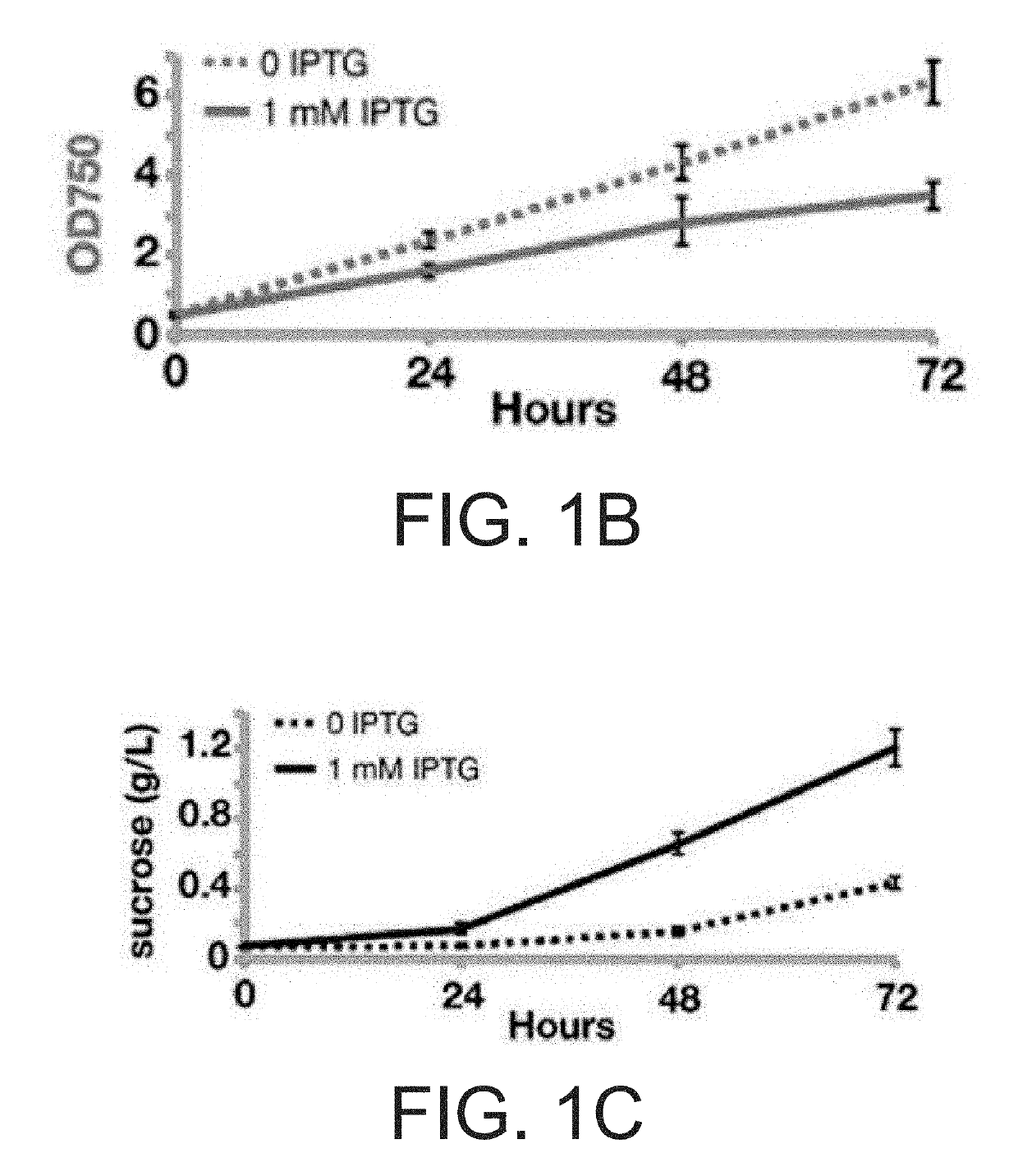Two phase sustainable photoproduction via co-cultivation of encapsulated, carbohydrate-producing cyanobacteria
a technology of cyanobacteria and cyanobacteria, which is applied in the field of two-phase sustainable photoproduction via co-cultivation of encapsulated, carbohydrate-producing cyanobacteria, can solve the problems of bioplastic production with a significant carbon footprint, is vulnerable to economics, and monocultures of algae and cyanobacteria are vulnerable to many inefficiencies, so as to reduce the incidence of genetic mutations, reduce the loss of genetically engin
- Summary
- Abstract
- Description
- Claims
- Application Information
AI Technical Summary
Benefits of technology
Problems solved by technology
Method used
Image
Examples
example 1
and Methods
[0107]This Example describes some of the materials and methods used in the development of aspects of the invention.
Strains, Media, and Axenic Characterization
[0108]S. elongatus PCC 7942 (obtained from ATCC #33912) was engineered to secrete sucrose through the expression of the sucrose / proton symporter cscB [Ducat et al., Appl Environ Microbiol. 78: 2660-82 (2012)]. E. coli W was obtained from ATCC (accession no. 9637) and the E. coli W ΔcscR strain is described in Arifin et al. (J Biotechnol. 156:275-8 (2011)). B. subtilis 168 was obtained from ATCC (accession no. 23857) and B. subtilis 3610 Δ sin I is described by Kearns et al. (Mol Microbiol. 55:739-49 (2005)). The Δ sin I mutant strain of 3610 was used to minimize chained growth making CFU counts of the strain reproducible (Kearns et al. Mol Microbiol. 55:739-49 (2005)). S. cerevisiae strains, WTW303 and W303Clump (previously referred to as Ancestor and Recreated02 strains, respectively) are described by Koschwanez et ...
example 2
eria can Form Consortia with Heterotrophs
[0136]Pairwise consortia were designed where cscB+ S. elongatus secreted sucrose in response to osmotic pressure combined with induction of cscB expression by isopropyl β-D-1-thiogalactopyranoside (IPTG) [Ducat et al. Appl Environ Microbiol. 78: 2660-8 (2012)]. Carbon secreted by cyanobacteria promoted growth of co-cultured heterotrophs as schematically illustrated in FIG. 1A.
[0137]Media with optimized compositions of nitrogen, salt, and buffer were developed: termed CoBBG-11 for use in cyanobacteria / bacteria consortia and CoYBG-11 for cyanobacteria / yeast co-culture (see Example 1). Tests verified that S. elongatus grows and produces sucrose in both CoBBG-11 and CoYBG-11 (FIGS. 1B, 1C, 1E, IF). Induction of cscB greatly enhanced the rate of sucrose export, and this redirection of carbon resources leads to slower growth of cscB+ S. elongatus (FIGS. 1B, 1C, 1E, 1F). All heterotrophs were assessed to confirm that they were capable of growth in a...
example 3
ven Cyanobacterial Metabolism Inhibits Heterotroph Viability
[0145]As illustrated in FIG. 3A, cyanobacterial light driven metabolism is a source of heterotroph growth inhibition when sucrose is not limiting. The lack of monotonic growth in B. subtilis and S. cerevisiae co-cultures indicates that interactions beyond sucrose feeding are occurring between heterotrophs and cyanobacteria (FIGS. 2A and 2D).
[0146]Experiments were performed to determine the source of the heterotroph growth inhibition. To focus on products other than sucrose concentrations that could influence heterotrophic viability and eliminate the confounding factor that cyanobacteria only generate sucrose in the light [Ducat et al., Appl Environ Microbiol. 78: 2660-8 (2012)], co-cultures were supplemented with exogenous sucrose (2%) and cultivated in the light or dark. After 12 hours of co-cultivation, heterotroph viability of each of the three species (S. elongatus, B. subtilis and S. cerevisiae) was determined.
[0147]FI...
PUM
| Property | Measurement | Unit |
|---|---|---|
| diameters | aaaaa | aaaaa |
| diameters | aaaaa | aaaaa |
| diameters | aaaaa | aaaaa |
Abstract
Description
Claims
Application Information
 Login to View More
Login to View More - R&D
- Intellectual Property
- Life Sciences
- Materials
- Tech Scout
- Unparalleled Data Quality
- Higher Quality Content
- 60% Fewer Hallucinations
Browse by: Latest US Patents, China's latest patents, Technical Efficacy Thesaurus, Application Domain, Technology Topic, Popular Technical Reports.
© 2025 PatSnap. All rights reserved.Legal|Privacy policy|Modern Slavery Act Transparency Statement|Sitemap|About US| Contact US: help@patsnap.com



